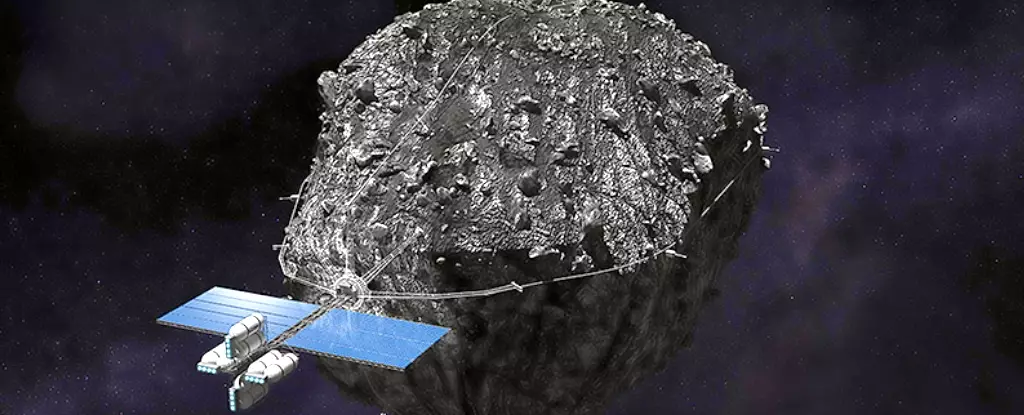Asteroid mining has garnered significant attention, particularly as modern media often emphasizes extravagant monetary valuations of celestial bodies. Take, for example, the focus on the metallic asteroid Psyche—often touted as worth an astonishing $10 quintillion. While such staggering figures do make for captivating headlines, they prompt an essential inquiry: Are these valuations grounded in reality, or are they merely hyperbolic numbers designed to pique interest?
Asteroids are composed of various materials, making it imperative to understand what exactly can be mined and how valuable those resources truly are. A recent research study, backed by Astroforge—a burgeoning asteroid mining company—and conducted by experts from Colorado School of Mines, addressed this question by meticulously categorizing the types of metals that can be harvested from asteroids. The findings were illuminating. The study distinguishes two primary categories of metals: those deemed economically viable for return to Earth and those that are better utilized in space itself.
The platinum-group metals (PGMs), including rhodium and platinum, were identified as the only candidates worth returning to Earth due to their high demand and price. These metals are inherently valuable for their broad applications—from catalytic converters to various high-tech innovations. Their rarity and escalating prices create a potent economic incentive for asteroid miners to target them specifically. Conversely, metals like iron, aluminum, and magnesium, while abundant in space, have considerably lower terrestrial market values. Their utility lies primarily in constructing in-space infrastructure, such as solar arrays and habitats, suggesting a dual-role mining strategy where some materials are used on-site rather than shipped back to Earth.
However, this leads to a significant dilemma: the “chicken-and-egg” problem regarding demand and supply. Currently, the costs associated with mining asteroids and transporting metals to Earth are not competitive with the prices of equivalent terrestrial materials. For context, mining and launching materials into space can cost upwards of $10,000 per kilogram. Given this, the feasibility of asteroid mining hinges on developing technologies to effectively utilize and process these materials in space, which remains a costly venture.
The insights gleaned from the study reveal that many assumptions about the composition of asteroids may not hold true. Contrary to the popular belief that asteroids like Psyche are made of “pure metals,” research indicates that these celestial bodies often consist of a more complex chemical makeup. This revelation not only dampens overly optimistic evaluations but also opens up new avenues for understanding the diversity of asteroids. Comparative studies of meteorites—essentially asteroid remnants that have fallen to Earth—provide crucial data on the possible metal content of asteroids, enhancing our understanding of what could genuinely be extracted.
Recent findings about refractory metal nuggets (RMNs) showcase that some asteroids might harbor concentrations of PGMs much higher than terrestrial ores. These RMNs, typically found on L-type asteroids, could revolutionize the landscape of asteroid mining if successfully extracted. However, challenges abound. RMNs occur in sizes measured in microns, which complicates their extraction and processing. The current extraction methods may yield metals in concentrations several orders of magnitude greater than Earth’s regolith, yet the logistics of large-scale mining operations remain daunting.
Moreover, processing metals in their oxidized states from asteroids presents another layer of difficulty. High-energy techniques, such as molten regolith electrolysis, may be required to release usable forms of metals. Yet, the requirement for a reliable power source to support these high-energy processes underscores the interdependence of mining operations and energy efficiency in space.
The trajectory for asteroid mining, especially for companies like Astroforge, appears to revolve around fundamental technological advancements that will mitigate the challenges faced. With upcoming missions planned to rendezvous with near-Earth asteroids, researchers and miners alike are hopeful that these explorations will yield vital information on both composition and viability.
While the potential wealth contained in asteroids might be immense, pursuing unparalleled riches requires a sober evaluation of the challenges inherent in the mining process. The true economic viability of asteroid mining will rely not just on the availability of resources, but on our ability to adapt and innovate in extracting and utilizing those resources effectively. As research and technological development progress, the dreams of turning the cosmos into a site of resource extraction may one day transform from science fiction into reality—and understanding the realities behind those ambitions is the first step toward success.


Leave a Reply